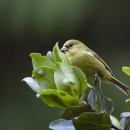Distribution: Once common on the Alakaʻi plateau and in other high elevation forests on the island of Kauaʻi, ʻakekeʻe populations began to rapidly decline in the early 2000s. These population declines match studies showing increasing malaria prevalence in native forest birds and changes in climate favorable to mosquitoes. Furthermore, field biologists are observing mosquitoes throughout the natural range of ʻakekeʻe where historically, mosquitoes did not occur. Wild populations are now restricted to high elevation ʻōhiʻa forests on the Alakaʻi plateau.
Behavior: ʻAkekeʻe are not territorial and they appear to wander across the landscape, which makes finding nests and collecting eggs difficult. They are very stress-prone in captivity, potentially due to changes in social dynamics and the inability to wander. To date, no ʻakekeʻe have successfully bred in captivity.
Current Status: Estimated wild population in 2021 is 638 individuals. In addition, there are seven individuals in captivity. Estimated year of extinction is 2023 to 2034, most likely 2028.
Link to ECOS ECOS
Environmental Conservation Online System (ECOS) serves a variety of reports related to FWS Threatened and Endangered Species.
Learn more about ECOS https://ecos.fws.gov/ecp/species/153




